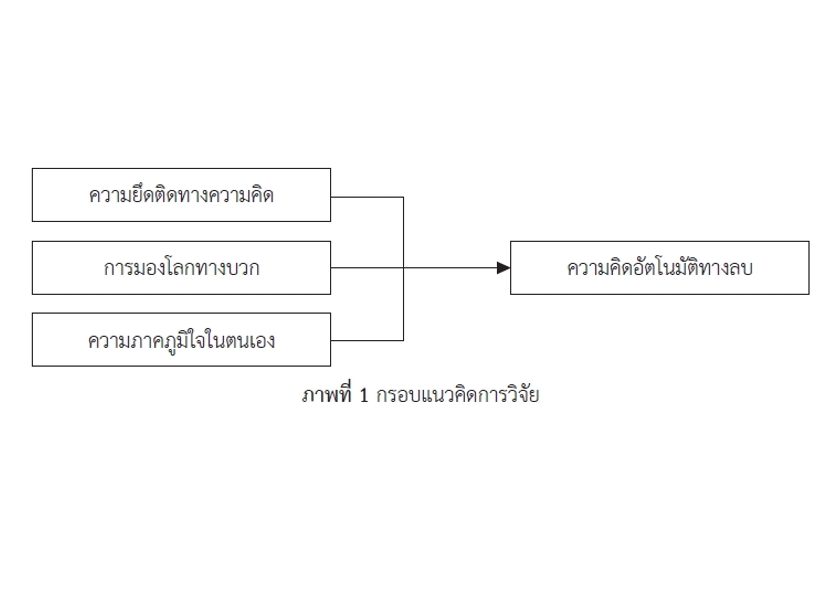ปัจจัยทำนายความคิดอัตโนมัติทางลบของเยาวชนที่ติดสารแอมเฟตามีน ในเรือนจำกลางภาคตะวันออก
คำสำคัญ:
ความคิดอัตโนมัติทางลบ, เยาวชนที่ติดสารเสพติด, เรือนจำกลางชลบุรีบทคัดย่อ
การศึกษานี้เป็นการวิจัยเชิงบรรยายชนิดหาความสัมพันธ์เชิงทำนายเพื่อศึกษาปัจจัยทำนายความคิดอัตโนมัติทางลบของเยาวชนที่ติดสารแอมเฟตามีนในเรือนจำกลางชลบุรี กลุ่มตัวอย่างเป็นเยาวชนชายที่ติดสารแอมเฟตามีนในเรือนจำกลางชลบุรี จำนวน 450 คน เครื่องมือที่ใช้ในการวิจัย ได้แก่ แบบสอบถามข้อมูลส่วนบุคคล แบบสอบถามความคิดอัตโนมัติทางลบ แบบสอบถามความภาคภูมิใจในตนเอง แบบสอบถามความยึดติดทางความคิด และแบบสอบถามการมองโลกทางบวก วิเคราะห์ข้อมูลด้วยสถิติพรรณนา และสถิติการวิเคราะห์ถดถอยแบบพหุคูณแบบขั้นตอน
ผลการศึกษาพบว่า เยาวชนที่ติดสารแอมเฟตามีนมีความคิดอัตโนมัติทางลบเฉลี่ย 57.60 (SD=19.896) และปัจจัยที่มีอิทธิพลต่อความคิดอัตโนมัติทางลบของเยาวชนที่ติดสารแอมเฟตามีนในเรือนจำกลางชลบุรีมากที่สุด ได้แก่ การยึดติดทางความคิด (β=.497, p<.001) รองลงมา คือ การมองโลกทางบวก (β=-.211, p<.001) และความภาคภูมิใจในตัวเอง (β=.129, p<.01) โดยสามารถร่วมกันทำนายความแปรปรวนของความคิดอัตโนมัติทางลบของเยาวชนที่ติดสารแอมเฟตามีนในเรือนจำกลางชลบุรีอย่างมีนัยสำคัญทางสถิติได้ร้อยละ 42.40 (R2=.424, p< .001)
ผลการศึกษานี้เป็นข้อมูลพื้นฐานที่สำคัญสำหรับพยาบาลวิชาชีพประจำเรือนจำในการพัฒนาโปรแกรมหรือกิจกรรมที่เน้นการลดความยึดติดทางความคิด เพิ่มการมองโลกทางบวก และความภาคภูมิใจในตนเองเพื่อให้เยาวชนกลุ่มนี้มีความคิดอัตโนมัติทางลบลดลง
เอกสารอ้างอิง
Beck, J. S. (2021). Cognitive behavior therapy: Basics and beyond (3rd ed.). New York, NY: The Guilford Press.
Chailanka, P., Thepthien, B., & Chucharoen, P. (2017). Depression, automatic negative thought, attitude distortion and cognitive distortion of methamphetamine addicts age 18-24 years. KKU Journal for Public Health Research, 10(1), 73-85.
Chang, E. C. (1996). Cultural differences in optimism, pessimism, and coping: Predictors of subsequent adjustment in Asian American and Caucasian American college students. Journal of Counseling Psychology, 43, 113-123.
Eamsuphasit, S. (2019). Theory and techniques of behavioral modification (9th ed.). Bangkok, Thailand: Chulalongkorn University Press.
Faul, F., Erdfelder, E., Lang, A.-G., & Buchner, A. (2007). G*Power 3: A flexible statistical power analysis program for the social, behavioral, and biomedical sciences. Behavior Research Methods, 39, 175–191.
Hayes, S. C., Luoma, J. B., Bond, F. W., Masuda, A., & Lillis, J. (2006). ACT: Model, processes and outcomes. Behaviour Research and Therapy, 44(1), 1-25.
Hollon, S. D., & Kendall, P. C. (1980). Cognitive self-statements in depression: Development of an automatic thoughts questionnaire. Cognitive Therapy and Research, 4(4), 383-395.
Kantiya, W., & Uthis, P. (2022). Selected factors related to depression of prisoners with methamphetamine dependence. Journal of Nursing Science Chulalongkorn University, 34(1), 78-91.
Khidsanguan, S. (2023). Factors affecting mental health among female prisoners in Chonburi Women’s Correctional Institution. Regional Health Promotion Center 9, 17(1), 167-180.
Lakthong, S., & Chaimongkol, N. (2021). Restoring life period: The experience of recovery as told by drug-treated male youth. Journal of The Royal Thai Army Nurses, 22(1), 370-379.
Majer, J. M., Jason, L. A., & Olson, B. D. (2004). Optimism, abstinence self-efficacy, and self-mastery: A comparative analysis of cognitive resources. Assessment, 1, 57-63.
Mathurapotpong, S. (2012). Hope, optimism, and resilience as predictors of performance, job satisfaction, work happiness, and organizational commitment. Veridian E-Journal, SU, 5(3), 306-318.
Office of the Narcotics Control Board. (2024). Report on monitoring the spread of narcotic drugs from forensic medicine/forensic science project (the first quarter of 2024). Bangkok, Thailand: Office of the Narcotics Control Board, Ministry of Justice.
Peden, A. R., Hall, L. A., Rayens, M. K., & Beebe, L. (2000). Negative thinking mediates the effect of self-esteem on depressive symptoms in college women. Nursing Research, 49(4), 201-207.
Popa, C. O., Rus, A. V., Lee, W. C., Cojocaru, C., Schenk, A., Vacara, V., & Bredicean, C. (2022). The relation between negative automatic thoughts and psychological inflexibility in schizophrenia. Journal of Clinical Medicine, 11(3), 871.
Rosenberg, M. (1979). Conceiving the self. New York, NY: Basic Books.
Sanseeha, L. (1993). Depression and negative automatic thoughts of late adolescents (Unpublished Master’s thesis). Chiang Mai University, Thailand.
Scheier, M. F., & Carver, C. S. (1985). Optimism, coping, and health: Assessment and implications of generalized outcome expectancies. Health Psychology, 4, 219-247.
Silpakit, P., & Silpakit, O. (2016). The psychometric property of Rosenberg Self-Esteem Scale in Thai youth. Journal of Mental Health Thailand, 24(1), 15-28.
Suphapan, S., & Sukonthaphirom Na Phatthalung, A. (2015). A study of the relationship between self-esteem and risk behaviors for HIV infection among inmates in a therapeutic community program at a northeastern correctional facility. Chulalongkorn Medical Journal, 59(1), 75-89.
Vatanasin, D. (2023). Adolescent depression: Basic concepts and nursing care (2nd ed.). Chiang Mai, Thailand: Wanida Press.
Vatanasin, D., Thapinta, D., Thompson, E. A., & Thungiaroenkul, P. (2012). Testing a model of depression among Thai adolescents. Journal of Child and Adolescent Psychiatric Nursing, 25(4), 195-206.
Vatanasin, D., Hengudomsub, P., Vatanasin, S., Asarath, T., Chupan, S., & Srisopa, P. (2015). Factors predicting depression among health science students. Journal of Faculty of Nursing Burapha University, 23(4), 31-47.
Vattanasin, D., & Dallas, J. C. (2021). Psychometric properties test of the cognitive fusion questionnaire (Thai version). Journal of Nursing Burapha University, 29(1), 80–92.
United Nations Office on Drugs and Crime (UNODC). (2024). World drug report 2024. New York, NY: United Nations.
Yavuzer, Y., Karatas, Z., Civilidag, A., & Gundogdu, R. (2014). The role of peer pressure, automatic thoughts and self-esteem on adolescents' aggression. Eurasian Journal of Educational Research, 54, 61-78.

ดาวน์โหลด
เผยแพร่แล้ว
รูปแบบการอ้างอิง
ฉบับ
ประเภทบทความ
สัญญาอนุญาต

อนุญาตภายใต้เงื่อนไข Creative Commons Attribution-NonCommercial-NoDerivatives 4.0 International License.




